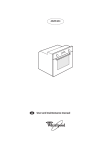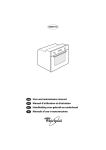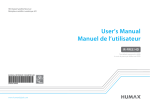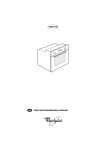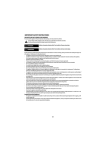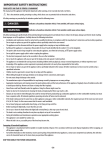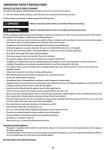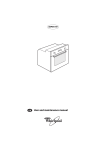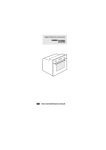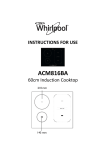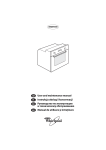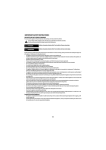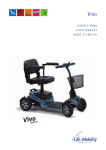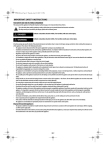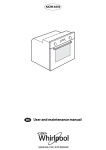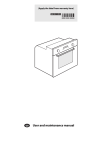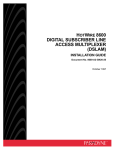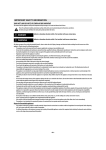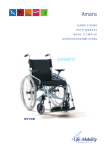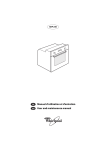Download User and maintenance manual
Transcript
AKZM 655 User and maintenance manual IMPORTANT SAFETY INSTRUCTIONS YOUR SAFETY AND THAT OF OTHERS IS PARAMOUNT This manual and the appliance itself provide important safety warnings, to be read and observed at all times. This is the danger symbol, pertaining to safety, which alerts users to potential risks to themselves and others. All safety warnings are preceded by the danger symbol and the following terms: DANGER Indicates a hazardous situation which, if not avoided, will cause serious injury. WARNING Indicates a hazardous situation which, if not avoided, could cause serious injury. All safety warnings give specific details of the potential risk present and indicate how to reduce risk of injury, damage and electric shock resulting from improper use of the appliance. Carefully observe the following instructions: The appliance must be disconnected from the power supply before carrying out any installation work. Installation and maintenance must be carried out by a qualified technician, in compliance with the manufacturer’s instructions and local safety regulations. Do not repair or replace any part of the appliance unless specifically stated in the user manual. Regulations require that the appliance is earthed. The power cable must be long enough for connecting the appliance, once fitted in its housing, to the power supply socket. If the supply cord is damaged, it must be replaced by the manufacturer, its service agent or similar qualified persons in order to avoid a hazard. For installation to comply with current safety regulations, an all-pole disconnect switch with minimum contact gap of 3 mm must be utilized. Do not use multiple plug adapters or extension leads. Do not pull the power supply cable in order to unplug the appliance. The electrical components must not be accessible to the user after installation. Do not touch the appliance with any wet part of the body and do not operate it when barefoot. This appliance is designed solely for use as a domestic appliance for cooking food. No other type of use is permitted (e.g.: heating rooms). The Manufacturer declines all responsibility for inappropriate use or incorrect setting of the controls. The appliance is not intended for use by persons (including children) with any physical, sensory or mental impairment, or without experience and knowledge of the appliance, unless supervised or previously instructed in its use by those responsible for their safety. The accessible parts of the appliance may become very hot during use. Young children should be kept away from the appliance and supervised to ensure that they do not play with it. During and after use, do not touch the heating elements or interior surfaces of the appliance - risk of burns. Do not allow the appliance to come into contact with cloths or other flammable materials until all the components have cooled sufficiently. At the end of cooking, exercise caution when opening the appliance door, letting the hot air or steam exit gradually before accessing the oven. When the appliance door is shut, hot air is vented from the aperture above the control panel. Do not obstruct the vent apertures. Use oven gloves to remove pans and accessories, taking care not to touch the heating elements. Do not place flammable materials in or near the appliance: a fire may break out if the appliance is inadvertently switched on. Do not heat or cook sealed jars or containers in the appliance. The pressure that builds up inside might cause the jar to explode, damaging the appliance. GB1 - - Do not use containers made of synthetic materials. Overheated oils and fats catch fire easily. Always remain vigilant when cooking foods rich in fat and oil. Never leave the appliance unattended during food drying. If alcoholic beverages are used when cooking foods (e.g. rum, cognac, wine), remember that alcohol evaporates at high temperatures. As a result, there is a risk that vapours released by the alcohol may catch fire upon coming into contact with the electrical heating element. Do not use harsh abrasive cleaners or sharp metal scrapers to clean the oven door glass since they can scratch the surface, which may result in shattering of the glass. Scrapping of household appliances - This appliance is manufactured with recyclable or reusable materials. Dispose of it in accordance with local waste disposal regulations. Before scrapping, cut off the power supply cable. For further information on the treatment, recovery and recycling of household electrical appliances, contact your competent local authority, the collection service for household waste or the store where you purchased the appliance. INSTALLATION After unpacking the oven, make sure that it has not been damaged during transport and that the oven door closes properly. In the event of problems, contact the dealer or your nearest After-sales Service. To prevent any damage, only remove the oven from its polystyrene foam base at the time of installation. PREPARING THE HOUSING UNIT • • • • Kitchen units in contact with the oven must be heat resistant (min 90°C). Carry out all cabinet cutting work before fitting the oven in the housing and carefully remove all wood chips and sawdust. After installation, the bottom of the oven must no longer be accessible. For correct appliance operation, do not obstruct the minimum gap between the worktop and the upper edge of the oven. ELECTRICAL CONNECTION Make sure the power voltage specified on the appliance dataplate is the same as the mains voltage. The dataplate is on the front edge of the oven (visible when the door is open). • Power cable replacement (type H05 RR-F 3 x 1.5 mm) must be carried out by a qualified electrician. Contact an authorized service centre. GENERAL RECOMMENDATIONS Before use: - Remove cardboard protection pieces, protective film and adhesive labels from accessories. Remove the accessories from the oven and heat it at 200° for about an hour to eliminate the smell and fumes from the insulating materials and protective grease. During use: - Do not place heavy objects on the door as they could damage it. Do not cling to the door or hang anything from the handle. Do not cover the inside of the oven with aluminium foil. Never pour water into the inside of a hot oven; this could damage the enamel coating. Never drag pots or pans across the bottom of the oven as this could damage the enamel coating. Make sure that the electrical cables of other appliances do not touch hot parts of the oven or become trapped in the door. Do not expose the oven to atmospheric agents. GB2 SAFEGUARDING THE ENVIRONMENT Disposal of packing material The packing material is 100% recyclable and is marked with the recycle symbol ( ). The various parts of the packing must therefore be disposed of responsibly and in full compliance with local authority regulations governing waste disposal. Scrapping the product - This appliance is marked in compliance with European Directive 2002/96/EC, Waste Electrical and Electronic Equipment (WEEE). By ensuring this product is disposed of correctly, you will help prevent potential negative consequences for the environment and human health, which could otherwise be caused by inappropriate waste handling of this product. - The symbol on the product or on the accompanying documentation indicates that it should not be treated as domestic waste but must be taken to an appropriate collection centre for the recycling of electrical and electronic equipment. Energy saving - Only pre-heat the oven if specified in the cooking table or your recipe. Use dark lacquered or enamelled baking moulds as they absorb heat far better. Switch the oven off 10/15 minutes before the set cooking time. Food requiring prolonged cooking will continue to cook even once the oven is switched off. DECLARATION OF CONFORMITY - This oven, which is intended to come into contact with foodstuffs, complies with European Regulation ( ) n.1935/2004 and has been designed, manufactured and sold in conformity with the safety requirements of the “Low Voltage” directive 2006/95/CE (which replaces 73/23/CEE and subsequent amendments), the protection requirements of “EMC” directive 89/336/CEE and the requirements of directive 93/68/CEE. TROUBLESHOOTING GUIDE The oven does not work: • • Check for the presence of mains electrical power and if the oven is connected to the electrical supply. Turn off the oven and restart it to see if the fault persists. The door will not open: • • Turn off the oven and restart it to see if the fault persists. Important: during self-cleaning, the oven door will not open. Wait until it unlocks automatically (see paragraph “Cleaning cycle of ovens with pyrolysis function”). The electronic programmer does not work: • If the display shows the letter “ ” followed by a number, contact your nearest After-sales Service. Specify in this case the number that follows the letter “ ”. GB3 AFTER-SALES SERVICE Before calling the After-Sales Service: 1. See if you can solve the problem yourself with the help of the suggestions given in the “Troubleshooting guide“. 2. Switch the appliance off and back on again it to see if the fault persists. If after the above checks the fault still occurs, get in touch with the nearest After-sales Service. Always specify: • a brief description of the fault; • the type and exact model of the oven; • the service number (number after the word Service on the rating plate), located on the right hand edge of the oven cavity (visible when the oven door is open). The service number is also indicated on the guarantee booklet; • your full address; • your telephone number. If any repairs are required, please contact an authorised After-sales Service (to guarantee that original spare parts will be used and repairs carried out correctly). CLEANING WARNING - Never use steam cleaning equipment. Only clean the oven when it is cool to the touch. Disconnect the appliance from the power supply. Oven exterior IMPORTANT: do not use corrosive or abrasive detergents. If any of these products accidentally comes into contact with the appliance, clean immediately with a damp cloth. • Clean the surfaces with a damp cloth. If it is very dirty, add a few drops of washing up detergent to the water. Finish off with a dry cloth. Oven interior IMPORTANT: do not use abrasive sponges or metallic scrapers or scourers. Over time, these can ruin enamelled surfaces and the oven door glass. • After every use, allow the oven to cool then clean it preferably while it is still warm in order to remove built-up dirt and stains caused by food residues (e.g. food with a high sugar content). • Use proprietary oven detergents and follow the manufacturer’s instructions to the letter. • Clean the door glass with a suitable liquid detergent. The oven door can be removed to facilitate cleaning (see MAINTENANCE). • The top heating element of the grill (see MAINTENANCE) can be lowered (some models only) to clean the roof of the oven. N.B: during prolonged cooking of foods with a high water content (e.g. pizza, vegetables, etc.) condensation may form on the inside of the door and around the seal. When the oven is cold, dry the inside of the door with a cloth or sponge. Accessories: • • Soak the accessories in water with washing up detergent immediately after use, handling them with oven gloves if still hot. Food residues can be easily removed using a brush or sponge. GB4 Cleaning the rear wall and catalytic side panels of the oven (if present): IMPORTANT: do not use corrosive or abrasive detergents, coarse brushes, pot scourers or oven sprays which could damage the catalytic surface and ruin its self-cleaning properties. • Operate the oven empty with the fan-assisted function at 200°C for about one hour • Next, leave the appliance to cool down before removing any food residue with a sponge. Cleaning cycle of ovens with pyrolysis function (if present): WARNING - Do not touch the oven during the pyrolysis cycle. Excess spillage must be removed before cleaning. During pyrolysis, the surfaces may get hotter than usual and children should be kept away. This function burns off spatters produced inside the oven during cooking at a temperature of approx. 500°C. At this high temperature, the deposits turn into a light ash which can be easily wiped away with a damp cloth, when the oven is cool. Do not select the pyrolysis function after every use, only when the oven is very dirty or produces smoke or fumes while preheating or cooking. • If the oven is installed below a hob, make sure that all burners or electric hotplates are switched off during the self-cleaning (pyrolysis) function. • Remove all accessories before running the pyrolysis function. The appliance is equipped with 2 pyrolysis functions: 1. Energy-saving cycle (PYRO EXPRESS/ECO): which consumes approximately 25% less energy than the standard cycle. Select it at regular intervals (after cooking meat on 2 or 3 consecutive occasions). 2. Standard cycle (PYRO): which is suitable for cleaning a very dirty oven. • In any case, after a certain number of uses and depending on how dirty the oven is, a message on the oven display advises you to run a self-cleaning cycle. N.B: during the pyrolysis function, the oven door will not open; it will remain locked until the temperature inside the oven has returned to an acceptably safe level. GB5 MAINTENANCE - WARNING Use safety gloves. Ensure the oven is cold before carrying out the following operations. Disconnect the oven from the power supply. REMOVING THE DOOR To remove the door: 1. 2. 3. Open the door fully. Lift the catches and push them forwards as far as they will go (fig. 1). Close the door as far as it will go (A), lift it up (B) and turn it (C) until it is released (D) (fig. 2). To refit the door: 1. 2. 3. 4. Fig. 1 Insert the hinges in their seats. Open the door fully. Lower the two catches. Close the door. Fig. 2 MOVING THE TOP HEATING ELEMENT (SOME MODELS ONLY) 1. 2. 3. Fig. 3 Remove the side accessory holder grilles (Fig. 3). Pull the heating element out a little (Fig. 4) and lower it (Fig. 5). To reposition the heating element, lift it up, pulling it slightly towards you, making sure it comes to rest on the lateral supports. Fig. 4 Fig. 5 GB6 REPLACING THE OVEN LAMP To replace the rear lamp (if present): 1. Disconnect the oven from the power supply. 2. Unscrew the lamp cover (Fig. 6), replace the lamp (see note for lamp type) and screw the lamp cover back on. 3. Reconnect the oven to the power supply. To replace the side lamp (if present): 1. Disconnect the oven from the power supply. 2. Remove the side accessory holder grilles, if present (Fig. 3). 3. Use a screwdriver to prise off the lamp cover (Fig. 7). 4. Replace the lamp (see note for lamp type). (Fig. 8) 5. Reposition the lamp cover, pushing it on firmly until it snaps into place (Fig. 9). 6. Refit the side accessory holder grilles. 7. Reconnect the oven to the power supply. Fig. 6 Fig. 7 Fig. 8 Fig. 9 N.B: Only use 25-40W/230V type E-14, T300°C incandescent lamps, or 20-40W/230 V type G9, T300°C halogen lamps. Lamps are available from our After-sales Service. IMPORTANT: If using halogen lamps, do not handle with bare hands since fingerprints can damage them. Do not use the oven until the lamp cover has been repositioned. GB7 INSTRUCTIONS FOR OVEN USE FOR ELECTRICAL CONNECTION, SEE THE PARAGRAPH ON INSTALLATION 1. Control panel 2. Upper heating element/grill 3. Cooling fan (not visible) 4. Dataplate (not to be removed) 5. Lamps 6. Circular heating element (not visible) 7. Fan 8. Turnspit (if present) 9. Lower heating element (not visible) 10. Door 11. Position of shelves (the number of shelves is indicated on the front of the oven) 12. Rear wall NOTE: During cooking, the cooling fan may switch on at intervals in order to minimise energy consumption. At the end of cooking, after the oven has been switched off, the cooling fan may continue to run for a while. When the oven door is opened during cooking, the heating elements switch off. ACCESSORIES SUPPLIED WIRE SHELF (n. 2): the wire shelf can be used to grill food or as a support for pans, cake tins and other ovenproof cooking receptacles. DRIP TRAY (n. 1): the drip tray is designed to be positioned under the wire shelf in order to collect fat or as an oven tray for cooking meat, fish, vegetables, focaccia, etc. GB8 ACCESSORIES NOT SUPPLIED Other accessories which can be purchased separately from the After-sales Service include baking trays, catalytic panels and a turnspit. INSERTING WIRE SHELVES AND OTHER ACCESSORIES IN THE OVEN The wire shelf and other accessories are provided with a locking mechanism to prevent their accidental removal. Fig. 1 1. 2. Insert the wire shelf horizontally, with the raised part “A” upwards (fig. 1). Angle the wire shelf when it reaches the locking position “B” (fig. 2). Fig. 2 Fig. 3 3. Return the wire shelf to the horizontal position and push it in fully to “C” (fig. 3). 4. To remove the wire shelf proceed in reverse order. The other accessories, like the drip tray and baking tray, are inserted in exactly the same way. The protrusion on the flat surface enables the accessories to lock in place. CONTROL PANEL DESCRIPTION ELECTRONIC PROGRAMMER Frozen Food Defrost Warm Keeping Specials: For defrosting food 1 3 DISPLAY 4 2 1. FUNCTION SELECTOR KNOB: On/off and function selector knob 2. BROWSE KNOB: for browsing the menu and adjusting pre-set values NOTE: the two knobs are retractable. Press the knobs in the middle and they pop up. 3. BUTTON : to return to the previous screen 4. BUTTON : to select and confirm settings GB9 LIST OF FUNCTIONS Turn the “Functions” knob to any position and the oven switches on: the display shows the functions or the associated submenus. The submenus are available and selectable by turning the knob to the functions GRILL, SPECIAL, SETTINGS, RECIPES and FAVOURITES. Frozen Food A Defrost B Warm Keeping Specials: For defrosting food C D A. B. C. D. Symbol for highlighted function Highlighted function can be selected by pressing Description of highlighted function Other available and selectable functions. DETAILS OF FUNCTION After selection of the desired function, the display will show further options and related details --:-- 180°C Zone 3 TEMPERATURE Zone 2 Yes PREHEAT COOK TIME Convection Bake Start --:-END TIME Zone 4 Zone 5 Cursor Zone 1 To move between the different areas, turn the “Browse” knob: the cursor moves to the adjustable values, following the order described above. Press button to select the value, change it by turning the “Browse” knob and confirm with button . USING THE APPLIANCE FOR THE FIRST TIME - LANGUAGE SELECTION AND SETTING THE TIME For correct use of the oven, when it is switched on for the first time you will have to select the desired language and set the correct time. Proceed as follows: 1. Turn the “Functions” knob to any position: the display will show the list of the first three available languages. 2. Turn the “Browse” knob to scroll the list. 3. When the desired language is highlighted, press to select it. After language selection, the display will flash 12:00. 4. Set the time by turning the “Browse” knob. 5. Confirm your setting by pressing . GB10 SELECTING COOKING FUNCTIONS --:-- 180°C TEMPERATURE Yes PREHEAT 1. 2. 3. Start --:-- 180°C COOK TIME Convection Bake TEMPERATURE --:-- Yes END TIME PREHEAT COOK TIME Convection Bake Start --:-END TIME If the oven is off, turn the “Functions” knob; the display will show the cooking functions or associated submenus. NOTE: for the list and description of functions, see the specific table at page 15 and at page 16. Within the submenus, browse the various options available by turning the “Browse” knob: the chosen function is highlighted in white in the centre of the screen. To select it, press . the cooking settings are displayed on the screen. If the pre-set values are those desired, turn the “Browse” knob to position the cursor at “Start” and then press ; otherwise, proceed as indicated above to change them. SETTING THE TEMPERATURE/OUTPUT OF THE GRILL 180°C --:-- TEMPERATURE No PREHEAT COOK TIME Conventional Start 200°C TEMPERATURE No PREHEAT --:-- Start No PREHEAT --:-- 200°C --:-END TIME --:-- TEMPERATURE END TIME COOK TIME Conventional 180°C COOK TIME Conventional Start --:-- TEMPERATURE No PREHEAT --:-END TIME COOK TIME Conventional Start --:-END TIME To change the temperature or output of the grill, proceed as follows: 1. Check that the cursor is positioned next to the temperature value (zone 1); press button to select the parameter to be changed: the temperature values flash. 2. Set the desired value by turning the “Browse” knob and press to confirm. 3. Turn the “Browse” knob to position the cursor at “Start” and then press . 4. The display indicates which shelf food should be placed on. Do as instructed and press to start cooking. The set temperature can also be changed during cooking by following the same procedure. 5. At the end of cooking, the end of cooking message is displayed. At this point the oven can be switched off by turning the “Functions” knob to 0 (zero), or cooking can be prolonged by turning the “Browse” knob clockwise. When switched off, the display shows the cooling bar which indicates the temperature inside the oven. PREHEATING THE OVEN --:-- 200°C TEMPERATURE No PREHEAT COOK TIME Conventional Start 200°C TEMPERATURE Yes PREHEAT --:-- Conventional Start TEMPERATURE No END TIME PREHEAT --:-- 200°C COOK TIME --:-END TIME --:-- 200°C COOK TIME Conventional Start --:-- TEMPERATURE Yes PREHEAT --:-END TIME COOK TIME Conventional Start --:-END TIME If you wish to preheat the oven before inserting food, change the oven’s default selection as follows: 1. Turn the “Browse” knob to position the cursor at preheating. 2. Press button to select the setting: “No” flashes on the display. 3. Change the setting by turning the “Browse” knob: the display shows “Yes”. 4. To confirm your choice, press button . GB11 FAST PREHEATING 180°C TEMPERATURE Frozen Food Defrost Warm Keeping Turn +/- to adjust ... Specials: For defrosting food Start If you wish to preheat the oven quickly before inserting food, change the oven’s default selection as follows: 1. Turn the “Functions” knob to select the fast preheating function. 2. Confirm by pressing : the settings are displayed on the screen. 3. If the proposed temperature is that desired, turn the “Browse” knob to position the cursor at “Start” and then press . To change the temperature, proceed as described in previous paragraphs. An acoustic signal will sound when the oven has reached the set temperature. At the end of preheating, the oven automatically selects the conventional function . At this point food can be placed in the oven for cooking. 4. If you wish to set a different cooking function, turn the “Functions” knob and select the desired function. SETTING COOKING TIME --:-- 180°C TEMPERATURE No PREHEAT COOK TIME Conventional Start --:-- - 00:30 180°C TEMPERATURE No HH:MM Conventional Start 19:01 END TIME PREHEAT 180°C 00:01 180°C - 00:30 TEMPERATURE HH:MM TEMPERATURE COOK TIME 19:01 No No PREHEAT Conventional Start END TIME PREHEAT Conventional Start END TIME 19:20 END TIME This function can be used to cook food for a set length of time, from a minimum of 1 minute to the maximum time allowed by the selected function, after which the oven switches off automatically. 1. To select the function, turn the “Browse” knob to position the cursor at “cooking duration”. 2. Press button to select the setting; “00:00” flashes on the display. 3. Change the value by turning the “Browse” knob to display the desired cooking time. 4. Confirm the selected value by pressing button . BROWNING At the end of cooking, with certain functions, the display indicates the possibility of browning. This function can only be used when cooking time has been set. - 00:05 COOK TIME Cooking finished at 20:00 + to prolong, ✓ to brown Browning 20:05 Browning finished at 20:05 END TIME At the end of cooking time, the display shows “+ to prolong, to brown”. Press button a 5 minute browning cycle. This function can only be used once after cooking. GB12 and the oven starts SETTING END OF COOKING TIME / DELAYED START The end of cooking time can be set, delaying the start of cooking by up to a maximum of 23 hours and 59 minutes. This can only be done once cooking time has been set. This setting is only possible when preheating is not required for the selected function. 180°C - 00:30 180°C - 00:30 TEMPERATURE COOK TIME TEMPERATURE COOK TIME Conventional No Start PREHEAT 19:20 Conventional No Start 19:20 END TIME PREHEAT 180°C - 00:30 180°C - 00:30 TEMPERATURE COOK TIME TEMPERATURE COOK TIME Conventional No Start PREHEAT 20:10 Conventional No Start END TIME 20:10 END TIME PREHEAT 180°C - 00:30 180°C - 00:29 TEMPERATURE COOK TIME TEMPERATURE COOK TIME Conventional No Start PREHEAT 20:10 END TIME Conventional No Start PREHEAT END TIME 20:10 END TIME After setting cooking time, the display shows the end of cooking time (for example 19:20). To delay the end of cooking time, and thus also the cooking start time, proceed as follows: 1. Turn the “Browse” knob to position the cursor at the end of cooking time. 2. Press button to select the setting: the end of cooking time flashes. 3. To delay the end of cooking time, turn the “Browse” knob to set the desired value. 4. Confirm the selected value by pressing button . 5. Turn the “Browse” knob to position the cursor at START and then press . 6. The display indicates which shelf food should be placed on. Do as instructed and press to start cooking. The oven will start cooking after a period of time calculated so as to finish cooking at the set time (for example, in the case of a dish which requires a cooking time of 20 minutes, if the end of cooking time is set to 20.10, the oven will begin cooking at 19.50). NOTE: During the interval before cooking starts, the oven can in any case be switched on by turning the “Browse” knob to position the cursor at “Start” and then pressing . At any time, set values (temperature, grill setting, cooking time) can be changed as described in previous paragraphs. INDICATION OF THE RESIDUAL HEAT INSIDE THE OVEN 168° 19:42 Residual Heat If at the end of cooking, or when the oven is switched off, the temperature inside the oven is over 50°C, the display shows the current temperature and the bar indicating cooling in progress. When the residual heat reaches 50°C, the display shows the current time. TIMER 00 : 00 : 00 00 : 30 : 00 (HH) (HH) (MM) (SS) Turn +/- to set Timer, ✓ to Start (MM) 01 : 09 : 00 (SS) Turn +/- to set Timer, ✓ to Start Timer This function can be used only with the oven switched off and is useful, for example, for monitoring the cooking time of pasta. The maximum time which can be set is 1 hour 30 minutes. 1. With the oven switched off, press button : the display will show “00:00:00”. 2. Turn the “Browse” knob to select the desired time. 3. Press button to start the countdown. When the set time has elapsed, the display will show “00:00:00” and an acoustic signal will sound. At this point the time can be prolonged, proceeding as described above, or the timer can be deactivated by pressing button (the time of day will be shown on the display). GB13 RECIPES Thanks to “Sixth sense” technology, the oven offers 30 pre-set recipes with ideal cooking temperatures. Simply follow the recipe as regards ingredients and the method of preparation. Then, proceed as follows: Dessert Dessert Meat Meat Fish Fish 6th Sense: Press ✓ to view recipes 6th Sense: Press ✓ to view recipes Kebabs Kebabs Pork Chops Pork Chops Shank of Pork Shank of Pork 6th Sense: See cookbook for description 6th Sense: See cookbook for description Automatic - 00:32 CONTROL COOK TIME Pork Chops Start 1. 2. 3. 4. 5. 6. 7. Insert food on level 3 Press ✓ when done 19:20 END TIME Select “RECIPES” by turning the “Functions” knob. Select the dish to be cooked from the proposed list. Confirm the selected dish using button . Select the desired recipe by turning the “Browse” knob. Confirm by pressing : the display shows the approximate cooking time. Place the dish in the oven and turn the “Browse” knob to position the cursor at “Start”, then press . The display indicates which shelf food should be placed on. Do as instructed and press to start cooking. To delay the start of cooking, see the relevant paragraph. Please turn food Cooking nearly finished Please check on food Cooking Finished at 19:45 Press to Prolong Cooking NOTES: Some dishes must be turned or stirred half way through cooking: the oven will emit an acoustic signal and the display will indicate what action is required. The initial cooking time displayed is merely for guidance: it can be prolonged automatically during cooking. Shortly before cooking time finishes, the oven prompts you to check that the food is cooked to your satisfaction. If it is not, extra time can then be added manually by turning the “Browse” knob. SETTINGS 1. To change some display settings, select “SETTINGS” from the main menu by turning the “Functions” knob. 2. Confirm by pressing : the display shows which settings can be changed (language, volume of acoustic signal, display brightness, time, energy saving function). 3. Select the setting to be changed by turning the “Browse” knob. 4. Press button to confirm. 5. Follow the instructions of the display to change the settings. 6. Press button ; a message appears on the display confirming your selection. NOTE: when the oven is switched off, if the ECOMODE (energy saving) function is selected (ON), the display switches off after a few seconds. If, on the other hand, the function is not selected (OFF), after a few seconds the display is merely dimmed. KEY-LOCK This function can be used to lock the buttons and knobs on the control panel. To activate it, press and at the same time for at least 3 seconds. If activated, the functions of the buttons are locked and the display shows a message and the symbol . This function can also be activated during cooking. To deactivate it, repeat the above procedure. When the key-lock function is activated, the oven can be switched off by turning the knob to 0 (zero). In this case, however, the previously selected function will have to be set again. GB14 FUNCTION DESCRIPTION TABLE Function selector knob OFF To halt cooking and switch off the oven. LAMP To switch the oven interior light on/off. FAST PREHEATING CONVENTIONAL To preheat the oven rapidly. To cook any kind of dish on one shelf only. Use the 3rd shelf. To cook pizza, savoury pies and sweets with liquid fillings, use the 1st or 2nd shelf. The oven does not have to be preheated. GRILL To grill steak, kebabs and sausages; to cook vegetables au gratin and toast bread. Place food on the 4th or 5th shelf. When grilling meat, use the drip tray to collect the cooking juices. Position it on the 3rd/4th shelf, adding approx. half a litre of water. The oven does not have to be preheated. During cooking the oven door must remain closed. TURBO GRILL To roast large joints of meat (legs, roast beef, chickens). Position the food on the middle shelves. Use the drip tray to collect the cooking juices. Position it on the 1st/2nd shelf, adding approx. half a litre of water. The oven does not have to be preheated. During cooking the oven door must remain closed. With this function you can also use the turnspit, if provided. FORCED AIR To cook a variety of food requiring the same cooking temperature on several shelves (maximum three) at the same time (e.g. fish, vegetables, cakes). This function can be used to cook different foods without odours being transferred from one food to another. Use the 3rd shelf to cook on one shelf only, the 1st and 4th to cook on two shelves, and the 1st, 3rd and 5th to cook on three shelves. The oven does not have to be preheated. CONVECTION BAKE To cook meat and pies with liquid filling (savoury or sweet) on a single shelf. Use the 3rd shelf. The oven does not have to be preheated. SPECIALS See SPECIAL FUNCTIONS. SETTINGS Setting the display (language, time, brightness, volume of acoustic signal, energy saving function). RECIPES FAVOURITES Selecting 30 different pre-set recipes (see enclosed recipe booklet). The oven automatically sets the optimum cooking temperature, function and time. It is important to follow the instructions given in the recipe book regarding preparation, accessories and which oven shelf to use. To directly access the 10 most used functions. To change the settings of the desired function, see paragraph “SELECTING COOKING FUNCTIONS”. GB15 SPECIAL DEFROSTING To speed up defrosting of food. Place food on the middle shelf. Leave food in its packaging in order to prevent it from drying out on the outside. KEEP WARM For keeping just-cooked food hot and crisp (e.g: meat, fried food or flans). Place food on the middle shelf. The function will not activate if the temperature in the oven is above 65°C. RISING For optimal rising of sweet or savoury dough. To safeguard the quality of proving, the function will not activate if the temperature in the oven is above 40°C. Place the dough on the 2nd shelf. The oven does not have to be preheated. CONVENIENCE Cooking ready meals kept at room temperature or from refrigerated cabinets (biscuits, liquid cake mixtures, muffins, first courses and bakery products). This function gently cooks all food quickly; it can also be used to reheat cooked food. Follow the instructions on the food packaging. The oven does not have to be preheated. MAXI COOKING To cook large joints of meat (above 2.5 kg). Use the 1st or 2rd shelves, depending on the size of the joint. The oven does not have to be preheated. The oven does not have to be preheated. It is advisable to turn the meat over during cooking for more even browning. It is best to baste the meat every now and again to prevent it from drying out. Lasagne Pizza FROZEN FOOD Strudel French fries The function automatically selects the ideal cooking temperature and mode for 5 different types of ready frozen food. Use the 2nd or 3rd shelf. The oven does not have to be preheated. Bread Custom The temperature can be set from 50 to 250°C to cook other types of product. GB16 COOKING TABLE Recipe Function Preheating - Shelf Temperature (from bottom) (°C) 2/3 160-180 Time (min) Accessories 30-90 Cake tin on wire shelf Leavened cakes Filled pies (cheesecake, strudel, apple pie) - 1-4 160-180 30-90 - 3 160-200 35-90 - 1-4 160-200 40-90 - 3 170-180 20-45 Shelf. 4: cake tin on wire shelf Shelf. 1: cake tin on wire shelf Drip tray/ baking tray or cake tin on wire shelf Shelf. 4: cake tin on wire shelf Shelf. 1: cake tin on wire shelf Drip tray or baking tray Shelf. 4: wire shelf - 1-4 160-170 20-45 Biscuits/Tartlets Shelf. 1: drip tray or baking tray Shelf. 5: oven tray on wire shelf - 1-3-5 160-170 20-45 Shelf. 3: oven tray on wire shelf Shelf. 1: drip tray or baking tray - - 3 1-4 180-200 180-190 30-40 35-45 Choux pastry Drip tray or baking tray Shelf. 4: oven tray on wire shelf Shelf. 1: drip tray or baking tray Shelf. 5: oven tray on wire shelf - 1-3-5 180-190 35-45 Shelf. 3: oven tray on wire shelf Shelf. 1: drip tray or baking tray GB17 Recipe Function Preheating - - Shelf Temperature (from bottom) (°C) 3 1-4 90 90 Time (min) Accessories 110-150 Drip tray or baking tray 140-160 Meringues Shelf. 4: oven tray on wire shelf Shelf. 1: drip tray or baking tray Shelf. 5: oven tray on wire shelf - 1-3-5 90 140-160 Shelf. 3: oven tray on wire shelf Shelf. 1: drip tray or baking tray - - 1/2 1-4 190-250 190-250 20-50 25-50 Bread / Pizza / Focaccia Drip tray or baking tray Shelf. 4: oven tray on wire shelf Shelf. 1: drip tray or baking tray Shelf. 5: oven tray on wire shelf - 1-3-5 190-250 25-50 Shelf. 3: oven tray on wire shelf Shelf. 1: drip tray or baking tray - - 3 1-4 180-190 180-190 40-55 45-60 Savoury pies (vegetable pie, quiche lorraine) Cake tin on wire shelf Shelf. 4: cake tin on wire shelf Shelf. 1: cake tin on wire shelf Shelf. 5: cake tin on wire shelf - 1-3-5 180-190 45-60 Shelf. 3: cake tin on wire shelf Shelf. 1: drip tray or baking tray + cake tin GB18 Recipe Function Preheating - - Shelf Temperature (from bottom) (°C) 3 1-4 190-200 180-190 Time (min) Accessories 20-30 Drip tray or baking tray 20-40 Vols-au-vent / Puff pastry crackers Shelf. 4: oven tray on wire shelf Shelf. 1: drip tray or baking tray Shelf. 5: oven tray on wire shelf - 1-3-5 180-190 20-40 Shelf. 3: oven tray on wire shelf Shelf. 1: drip tray or baking tray Lasagna / Baked pasta / Cannelloni / Flans - 3 190-200 45-55 Oven tray on wire shelf Lamb / Veal / Beef / Pork 1 Kg - 3 190-200 80-110 Drip tray or oven tray on wire shelf Chicken / Rabbit / Duck 1 Kg - 3 200-230 50-100 Drip tray or oven tray on wire shelf Turkey / Goose 3 Kg - 2 190-200 80-130 Drip tray or oven tray on wire shelf Baked fish / en papillote (fillet, whole) - 3 180-200 40-60 Drip tray or oven tray on wire shelf Stuffed vegetables (tomatoes, courgettes, aubergines) - 2 180-200 50-60 Oven tray on wire shelf Toast - 5 High 3-5 Fish fillets / steaks - 3-4 Medium 20-30 Grill Shelf. 4: wire shelf (turn food halfway through cooking) Shelf. 3: drip tray with water Sausages / Kebabs / Spare ribs / Hamburgers - 4-5 Medium-High 15-30 Shelf. 5: wire tray (turn food halfway through cooking) Shelf. 4: drip tray with water GB19 Recipe Function Preheating - Shelf Temperature (from bottom) (°C) 1-2 Medium Time (min) 55-70 Accessories Shelf. 2: wire tray (turn food two thirds of the way through cooking) Shelf. 1: drip tray with water Roast chicken 1-1.3 Kg Shelf. 2: Rotisserie - Roast Beef rare 1 Kg Leg of lamb / Shanks - - 1-2 3 3 High Medium Medium 60-80 Shelf. 1: drip tray with water 35-45 Oven tray on wire shelf (turn food two thirds of the way through cooking if necessary) 60-90 Drip tray or oven tray on wire shelf (turn food two thirds of the way through cooking if necessary) Roast potatoes - 3 Medium 45-55 Drip tray or baking tray (turn food two thirds of the way through cooking if necessary) Vegetables au gratin - 3 High 10-15 Oven tray on wire shelf Lasagna & Meat Meat & Potatoes Fish & Vegetables - - - 1-4 1-4 1-4 GB20 200 200 180 50-100 45-100 30-50 Shelf. 4: oven tray on wire shelf Shelf. 1: drip tray or oven tray on wire shelf Shelf. 4: oven tray on wire shelf Shelf. 1: drip tray or oven tray on wire shelf Shelf. 4: oven tray on wire shelf Shelf. 1: drip tray or oven tray on wire shelf Recipe Function Preheating - - Shelf Temperature (from bottom) (°C) 3 1-4 Auto Auto Time (min) 10-15 15-20 Accessories Drip tray / baking tray or wire shelf Shelf. 4: oven tray on wire shelf Shelf. 1: drip tray or baking tray Shelf. 5: oven tray on wire shelf - 1-3-5 Auto 20-30 Frozen pizza Shelf. 3: drip tray or baking tray Shelf. 1: oven tray on wire shelf Shelf. 5: oven tray on wire shelf - 1-3-4-5 Auto 20-30 Shelf. 4: drip tray or baking tray Shelf. 3: drip tray or baking tray Shelf. 1: oven tray on wire shelf GB21 Table of Tested Recipes (in compliance with IEC 60350:99+A1:05 +A2:08 and DIN 3360-12:07:07) Recipe Function Preheating Level (from Temperature bottom) (°C) Time (min) Accessories and notes IEC 60350:99+A1:05 +A2:08 § 8.4.1 - 3 170 20-30 Drip tray / baking tray - 1-4 160 20-30 - 3 170 25-35 Drip tray / baking tray - 1-4 160 30-40 Shortbread Shelf. 4: baking tray Shelf. 1: drip tray IEC 60350:99+A1:05 +A2:08 § 8.4.2 Small cakes - 1-3-5 160 35-45 Shelf. 4: baking tray Shelf. 1: drip tray Shelf. 5: oven tray on wire shelf Shelf. 3: baking tray Shelf. 1: drip tray IEC 60350:99+A1:05 +A2:08 § 8.5.1 Fatless sponge cake - 2 170 30-40 Cake tin on wire shelf - 2/3 185 70-90 Cake tin on wire shelf - 1-4 175 75-95 - 5 High 3-5 IEC 60350:99+A1:05 +A2:08 § 8.5.2 Two apple pies Shelf. 4: cake tin on wire shelf Shelf. 1: cake tin on wire shelf IEC 60350:99+A1:05 +A2:08 § 9.1.1 Toast Grill IEC 60350:99+A1:05 +A2:08 § 9.2.1 Burgers - 5 High Shelf. 5: wire tray (turn food 20-30 halfway through cooking) Shelf. 4: drip tray with water - 3 180 35-45 Drip tray / baking tray - 1-4 160 55-65 - 2 170 - 3 170 40-50 Drip tray / baking tray - 1-4 170 45-55 DIN 3360-12:07 § 6.5.2.3 Apple pie, cake in tin Shelf. 4: baking tray Shelf. 1: drip tray DIN 3360-12:07 § 6.6 Roast pork 110-150 Shelf. 2: drip tray DIN 3360-12:07 annex C Flat cake Shelf. 4: baking tray Shelf. 1: drip tray The cooking table advises the ideal function and cooking temperature to ensure the best results with all recipes. If you wish to cook on one shelf only using the fan-assisted function, place food on the third shelf and select the temperature recommended for the “FORCED AIR” function when cooking on more than one shelf. When grilling food, leave a space of 3-4 cm at the front to facilitate removal from the oven. GB22 RECOMMENDED USE AND TIPS How to read the cooking table The table indicates the best function to use for any given food, to be cooked on one or more shelves at the same time. Cooking times start from the moment food is placed in the oven, excluding pre-heating (where required). Cooking temperatures and times are purely for guidance and will depend on the amount of food and type of accessory used. Use the lowest recommended values to begin with and, if the food is not cooked enough, then move on to higher values. Use the accessories supplied and preferably dark coloured metal cake tins and oven trays. You can also use pans and accessories in pyrex or stoneware, but bear in mind that cooking times will be slightly longer. To obtain best results, carefully follow the advice given in the cooking table for the choice of accessories (supplied) to be placed on the various shelves. Cooking different foods at the same time Using the “FORCED AIR” function, you can cook different foods which require the same cooking temperature at the same time (for example: fish and vegetables), using different shelves. Remove the food which requires less cooking time and leave food which requires longer cooking time in the oven. Desserts - - Cook delicate desserts with the conventional function on one shelf only. Use dark coloured metal cake tins and always position them on the wire shelf supplied. To cook on more than one shelf, select the forced air function and stagger the position of the cake tins on the shelves, aiding optimum circulation of the hot air. To check whether a raising cake is cooked, insert a wooden toothpick into the centre of the cake. If the toothpick comes out clean, the cake is ready. If using non-stick cake tins, do not butter the edges as the cake may not rise evenly around the edges. If the cake “sinks” during cooking, set a lower temperature the next time, perhaps reducing the amount of liquid in the mixture and mixing more gently. For sweets with moist fillings (cheesecake or fruit pies) use the “CONVECTION BAKE” function. If the base of the cake is soggy, lower the shelf and sprinkle the bottom of the cake with breadcrumbs or biscuit crumbs before adding the filling. Meat - Use any kind of oven tray or pyrex dish suited to the size of the piece of meat being cooked. For roast joints, it is best to add some stock to the bottom of the oven tray, basting the meat during cooking for added flavour. When the roast is ready, let it rest in the oven for another 10-15 minutes, or wrap it in aluminium foil. When you want to grill meat, choose cuts with an even thickness all over in order to achieve uniform cooking results. Very thick pieces of meat require longer cooking times. To prevent the meat from burning on the outside, lower the position of the wire shelf, keeping the food farther away from the grill. Turn the meat two thirds of the way through cooking. To collect the cooking juices it is advisable to place a drip-tray with half a litre of water directly under the grill on which the meat is placed. Top-up when necessary. Turnspit (only in some models) Use this accessory to evenly roast large pieces of meat and poultry. Place the meat on the spit rod, tying it with string if chicken, and check that it is secure before inserting the rod in the seat located on the front wall of the oven and resting it on the respective support. To prevent smoke and to collect cooking juices, it is advisable to place a drip-tray with half a litre of water on the first level. The rod has a plastic handle which must be removed before starting to cook, and used at the end of cooking to avoid burns when taking the food out of the oven. Pizza Lightly grease the trays to ensure the pizza has a crispy base. Scatter the mozzarella over the pizza two thirds of the way through cooking. GB23 Dough proving function It is always best to cover the dough with a damp cloth before placing it in the oven. Dough proving time with this function is reduced by approximately one third compared to proving at room temperature (20-25°C). Proving time for a 1 Kg batch of pizza dough is around one hour. GB24 5019 310 56774 AU Whirlpool is a registered trademark of Whirlpool, USA Printed in Italy 07/2009




























